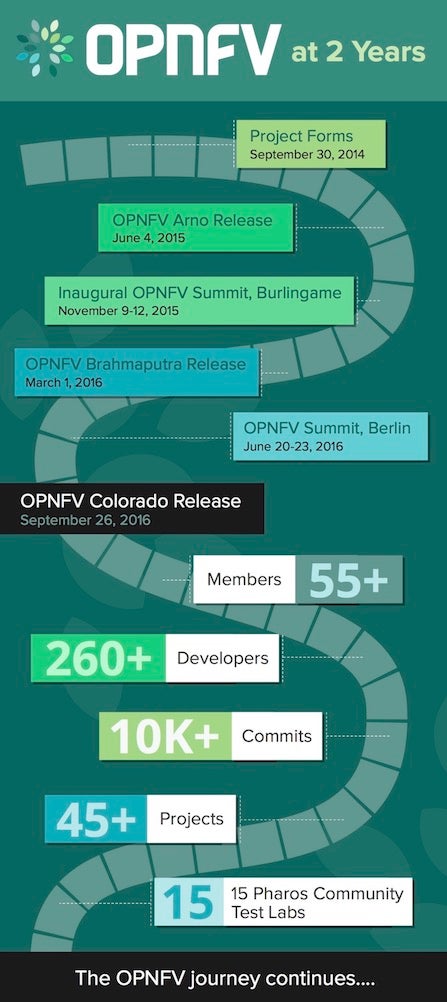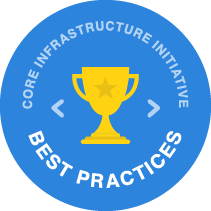OPNFV Colorado lays foundation for NFV applications and services via key feature enhancements, greater integration and additional testing capabilities
SAN FRANCISCO, September 26, 2016 — The OPNFV Project, an open source project that facilitates the development and evolution of Network Functions Virtualization (NFV) components across various open source ecosystems through integration, deployment, and testing today announced the availability of OPNFV Colorado, the project’s third platform release. Built on a strong underlying foundation, Colorado includes critical advances that accelerate the development of NFV applications and services through key feature enhancements across security, IPv6, Service Function Chaining (SFC), testing, VPN capabilities, and support for multiple hardware architectures.
“Colorado represents a more robust version of OPNFV’s previous Brahmaputra platform,” said Heather Kirksey, director, OPNFV. “The OPNFV community, in close collaboration with other upstream communities, has delivered enhanced capabilities most important to the NFV platform growth and maturity.”
Key enhancements available in OPNFV Colorado include:
- Core feature upgrades. These improvements come via focused collaboration with upstream communities and are centered on improving foundational support for NFV applications and services. All feature enhancements are integrated into the automated install/deploy/testing framework.
- Enhanced security by earning the Core Infrastructure Initiative (CII) Badge for best practices in open source development; additionally, the Moon project has been prototyping identity federation and management for OpenStack and OpenDaylight.
- Service Function Chaining (SFC) now runs across multiple nodes, includes installer support for VNF Manager (Tacker) installation and support for enhanced cloud scenarios.
- Improved IPv6 support includes IPv6-only deployments, full underlay and overlay support and integration with additional install tools.
- The SDN VPN project now enables full Layer 2 and Layer 3 VPN support including BGP peering.
- Full support for multiple hardware architectures, including both ARM® and x86 architectures.
- Enhanced testing capabilities. Colorado includes a greater integration across testing projects with additional feature testing capabilities, and increased automation.
- Infrastructure and testing environment advancements. The Phros Test Lab project continues to be a key element of OPNFV release development and validation. Colorado brings increased governance, consistency, availability and quality to the labs, increasing efficiency and ccreating the groundwork for a robust Lab-as-a-Service program. See the full list of Pharos labs –including those participating in Colorado–here.
- Community expansion. Improved cross-project collaboration via working groups focused on Management and Operation (MANO), Infrastructure, Security, and Testing. Five Committers-At-Large members have been elected to the Technical Steering Committee (TSC) to enhance the meritocratic nature of the project. OPNFV also continues to build relationships with key upstream communities such as OpenStack, OpenDaylight, ONOS, OpenContrail, FD.io, OVS, Open-O, OpenBaton, KVM, DPDK, ODP, and Linux. Additionally, OPNFV launched its intern program during the Colorado release timeframe, already providing valuable contributions across work on the Pharos Labs, VNF on-boarding and CINDR performance testing.
- Efficient network forwarding. Colorado introduces scenarios created by the FastDataStacks project which include the VPP software supplied bu the FD.io project to enable high-performance networking for NFV. More information on FastDataStacks can be found here.
“We’re seeing a maturity of process with the Colorado release, reflected by things like achievement of the CII Best Practices badge for security and the growing maturity of our testing and DevOps methodology,” said Chris Price, TSC chair, OPNFV and Open Source Manager for SDN, Cloud & NFV, Ericsson. “The creation of working groups across MANO, Infrastructure, Security, and Testing also help the project evolve towards a foundational and robust industry platform for advanced open source NFV.”
In addition to enhanced features and capabilities of the platform, the third OPNFV release has provided an opportunity for the community to become even more fluent in system level feature development and testing in support of NFV. This will be crucial in moving past the initial groundwork and into ease-of-deployment and end-user engagement as the platform continues to mature. Colorado sets the stage for significant new work in the MANO area including efforts focused on VNF on-boarding, increased CI/CD integration with upstream communities and ongoing NFV-related feature enhancements that will further accelerate the transformation of enterprise and service provider networks.
OPNFV is at the OpenDaylight Summit in Seattle this week, September 27-29. The community will participate in various presentations throughout the Summit and will host an OPNFV MeetUp onsite.
The second OPNFV Plugfest will be held December 5-9, 2016 at the University of New Hampshire Interoperability Lab in Durham, New Hampshire. The event will focus on interoperability of the OPNFV platform in three key areas of testing: OPNFV Deployment, Network Integration, and VNF Applications. Both OPNFV members and non-members are welcome to attend.
Information about OPNFV Colorado is available here: https://www.opnfv.org/colorado.
To learn more about OPNFV Colorado, or for information on how to participate in the OPNFV project, visit: https://www.opnfv.org.
Comments from key project contributors:
Bob Monkman, project technical lead for Armband project and segment marketing manager at ARM:
“OPNFV Colorado is an important new release as it continues the momentum towards a future-proof network based on multi-architectural solutions. The OPNFV Project is rapidly building an open, mature and integrated foundation to deliver NFV and we are engaged on a number of fronts, importantly on the Armband Project in open developer labs around the world.”
Bin Hu, Project Technical Lead for IPv6 project and PMTS at AT&T:
“With Colorado, we expanded upon the existing IPv6 support in Brahmaputra to now include overlay and underlay support and added support for additional install tools, including Apex, so support IPv6-only deployments. An important step for the platform, this brings advantages such as more efficient routing, more efficient packet processing, direct data flows, simplified network configuration, and enhanced security provided by a rapidly-growing IPv6 underlay infrastructure.”
Frank Brockners, Project Technical Lead for the FastDataStacks project and Distinguished Engineer, Cisco:
“To date, NFV stacks have been missing an esasy-to-extend, feature-rich, high-performance/scale virtual switch-router –integrated into a versatile stack architecture that can work with a variety of software and hardware forwarders. In Colorado with the FastDataStacks project, we have now overcome this hurdle and introduced a first OPNFV scenario that integrates the vector packet processor (VPP) as supplied by the FD.io project while leveraging OpenDaylight Group-Based Policy (BGP) as the integration vehicle.”
Brady Johnson, Project Technical Lead for SFC project and Principal Software Engineer at Ericsson:
“In the OPNFV Colorado release, SFC improves on the foundation laid in the Brahmaputra release by enhancing the stability of most of the upstream components that make up the project. We can now support more flexible and multi-node NSH networking scenarios. OPNFV, working with upstream teams, can now enable scenarios and network agility important to end users.”
Luke Hinds, Key project lead, CII Best Practice Badge and principal software engineer, RedHat:
“Security of the OPNFV ecosystem is critical to the trust and integrity of our community’s endeavor. The security posture of OPNFV is enhanced in Colorado by achievement of the Core Infrastructure Initiative (CII) Badge for best practices, and a full security code audit carried out by the OPNFV security working group. Colorado also includes two new security projects that set more secure standards movin forward: the Moon project prototypes identity federation for OpenStack and OpenDaylight and a second project which performs automated CI NFVi Security Scanning.”
About the Open Platform for NFV (OPNFV)
Open Platform for NFV (OPNFV) facilitates the development and evolution of NFV components across various open source ecosystems. Through system level integration, deployment and testing, OPNFV creates a reference NFV platform to accelerate the transformation of enterprise and service provider networks. For more information, please visit http://www.opnfv.org.
OPNFV is Collaborative Project at the Linux Foundation. Linux Foundation Collaborative Projects are independently funded software projects that harness the power of collaborative development to fuel innovation across industries and ecosystems. www.linuxfoundation.org.
Additional Resources
How to Participate
Download OPNFV Colorado
OPNFV Resources
OPNFV Blog
 Tapio Tallgren
Tapio Tallgren

 However, our progress has not come without challenges. In fact, when OPNFV first formed, we really weren’t sure if what we’re trying to do—orchestrate an entire industry to collaboratively create an open source NFV platform—would actually work. It’s an extremely daunting task, and, like any two-year-old, we are still trying to figure out the world around us and how to interact with it. While we’re feeling a bit more confident in our processes (e.g.,our recent Colorado release was delivered on the original release date) and are beginning to deliver real value into the open source ecosystem, there is certainly still work to be done (and, on occasion, we may suffer from a skinned knee). Things like refining our release processes, enhancing CI/CD, and delivering faster and better feedback to our upstream communities are crucial—along with longer-term goals like MANO integration and how we interact with technologies like Containers and IoT.
However, our progress has not come without challenges. In fact, when OPNFV first formed, we really weren’t sure if what we’re trying to do—orchestrate an entire industry to collaboratively create an open source NFV platform—would actually work. It’s an extremely daunting task, and, like any two-year-old, we are still trying to figure out the world around us and how to interact with it. While we’re feeling a bit more confident in our processes (e.g.,our recent Colorado release was delivered on the original release date) and are beginning to deliver real value into the open source ecosystem, there is certainly still work to be done (and, on occasion, we may suffer from a skinned knee). Things like refining our release processes, enhancing CI/CD, and delivering faster and better feedback to our upstream communities are crucial—along with longer-term goals like MANO integration and how we interact with technologies like Containers and IoT. Heather Kirksey
Heather Kirksey Chris Price
Chris Price
 Luke Hinds
Luke Hinds